Updated: April 2024
Printer-friendly .pdf version of the management information on this page.
See also:
- Newsletter articles:
Why Manage Cucurbit Powdery Mildew?
Managing Cucurbit Powdery Mildew Organically – Key Points for Success [Updated 2022-01-25]
Managing Cucurbit Powdery Mildew Conventionally – Key Points for Success [Updated 2022-01-25]
Conventional Fungicide Recommendations for Cucurbit Powdery Mildew - LIHREC Cucurbit powdery mildew photo gallery (includes diagnostic images)
- Research on powdery mildew conducted at LIHREC.
- Guidelines on managing cucurbit powdery mildew in 2022.
- Podcast: Avoiding the Powdery Mildew Blues – Meg McGrath, plant pathologist at Cornell’s Long Island Horticultural Research and Extension Center, discusses how with other members of the Great Lakes Vegetable Working Group on 24 June 2020. This and other recordings are in the green-bordered box at the bottom of this page.
- Listen to Meg McGrath talk about managing powdery mildew in a teleconference hosted by Steve Bogash of Marrone Bio Innovations on 22 July 2020. Dial 515-604-9875. At prompts enter 832191 for access code and 14 for reference number.
- Results from research on fungicide resistance in the cucurbit powdery mildew pathogen
- Targeted Fungicides for Cucurbit Powdery Mildew
- Table: Fungicides for Cucurbit Crops
- Table: Mobile Fungicides for Managing Three Major Cucurbit Diseases: Powdery Mildew, Downy Mildew, and Phytophthora Blight
Topics on this page:
- Impact and causal fungi
- Symptoms and signs
- Disease cycle
- Managing cucurbit powdery mildew – Overview
- Cultural and biological controls including resistant varieties
- Chemical control – General information
- Recommended targeted fungicides
- Organic fungicides for powdery mildew
- Summary points about managing powdery mildew successfully
Impact and causal fungi
Powdery mildew is a common disease of cucurbits under field and greenhouse conditions in most areas of the world. Although all cucurbits are susceptible, symptoms are less common on cucumber and melon because many commercial cultivars have resistance. This disease can be a major production problem. Quantity of yield is reduced due to a decrease in the size or number of fruit or a decrease in the length of the harvest period. Premature senescence of infected leaves can result in reduced market quality because fruit become sunburnt or ripen prematurely or incompletely. Such fruit have poor storability (winter squash), low soluble solids with consequent poor flavor (melon), poor rind color (pumpkin), and shriveled, discolored handles (pumpkin). Stress from disease can lead to imperfections on fruit rind such as speckling, raised indentations, and oedema. In addition, powdery mildew infection predisposes plants to other diseases, in particular, gummy stem blight.
Podosphaera xanthii (previously known as Sphaerotheca fuliginea and S. fusca) and Erysiphe cichoracearum are the two most commonly recorded fungi causing cucurbit powdery mildew. E. cichoracearum was considered to be the primary causal organism throughout most of the world before 1958. Today, P. xanthii is found more commonly worldwide. A shift in the predominance of these two fungi may have occurred or the causal organism may have been misidentified. P. xanthii is a more aggressive pathogen than E. cichoracearum. E. cichoracearum may have a lower temperature optimum since this species is found mainly during cooler spring and early summer periods and P. xanthii appears to progress most rapidly during the warmer months.
The conidia (spores produced asexually) of E. cichoracearum and P. xanthii are difficult to distinguish and chasmothecia, which are sexual fruiting bodies (structures containing spores produced through sexual reproduction), have been observed less commonly. Consequently, these fungi have been confused. The name of the fungus frequently has been reported without valid confirmation. Criteria for differentiating these fungi using the conidial stage were not identified until the 1960s. The main criterion used is presence of fibrosin bodies in conidia of P. xanthii. Based on these criteria, P. xanthii was found to be the predominant fungus, rather than E. cichoracearum as previously claimed, in several countries. During recent surveys E. cichoracearum was found rarely and only at the start of disease development in New York and other eastern states.
Symptoms and signs
White, powdery fungal growth develops on both leaf surfaces, petioles, and stems. This growth is primarily asexual spores called conidia. It usually develops first on crown leaves, on shaded lower leaves and on leaf undersurfaces. Yellow spots may form on upper leaf surfaces opposite powdery mildew colonies. Older plants are affected first. Infected leaves usually wither and die. Plants may senesce prematurely. Fruit infection occurs rarely on watermelon and cucumber. Chasmothecia are dark brown, small (diameter of about 0.003 inches) structures that are barely discernable without a hand lens. They develop late in the growing season. The sexual spores within these structures are protected from adverse conditions.
Images of symptoms are at the LIHREC Cucurbit powdery mildew photo gallery webpage.
Disease cycle
Source(s) of initial inoculum for powdery mildew have not been definitively determined. The primary initial inoculum is believed to be airborne conidia dispersed potentially long distances from other affected crops, starting in southern states where cucurbit crops are grown earlier in the year. Conidia remain viable for 7-8 days based on results from laboratory studies. The causal fungi are obligate parasites and therefore cannot survive in the absence of living host plants, except as chasmothecia. Possible local sources of initial inoculum include conidia from greenhouse-grown cucurbits, chasmothecia, and alternate hosts. Chasmothecia have been reported rarely in the United States; however, even when present they can be overlooked. They have been found every year in New York that they were looked for since 1989. Both mating types required for sexual reproduction have been found throughout the United States. Although P. xanthii and E. cichoracearum are described as having broad host ranges, strains of these fungi have been shown to be host-specific. The role of non-cucurbit hosts as sources of inoculum has not been investigated. Verbena, a common ornamental plant, could be an important source of inoculum, especially for cucurbits grown as a crop or transplants in the same greenhouse as verbena.
Powdery mildew develops quickly under favorable conditions because the length of time between infection and symptom appearance is usually only 3 to 7 days and a large number of conidia can be produced in a short time. Favorable conditions include dense plant growth and low light intensity. High relative humidity is favorable for infection and conidial survival; however, infection can take place as low as 50% RH. Dryness is favorable for colonization, sporulation, and dispersal. Rain and free moisture on the plant surface are unfavorable. However, disease development occurs in the presence or absence of dew. Mean temperature of 68-80°F is favorable; infection can occur at 50-90°F. Powdery mildew development is arrested when daytime temperatures are at least 100°F. Plants in the field often do not become affected until after fruit initiation. Susceptibility of leaves is greatest 16 to 23 days after unfolding.
Pathogenically distinct races of Podosphaera xanthii have been differentiated on muskmelon. Races 1 and 2 have most common in the eastern United States recently.
Managing cucurbit powdery mildew
Effectively managing powdery mildew is essential for producing a high-quality cucurbit crop. This foliar, fungal disease is common wherever cucurbits are grown, including in the northeastern U.S. This is because the pathogen produces an abundance of asexual spores (the powdery growth) easily dispersed by wind, thus it can spread widely, and the pathogen can produce a sexual spore in fall that enables it to survive over winter. Leaves affected by powdery mildew die prematurely which results in fewer fruit and/or fruit of low quality (poor flavor, sunscald, poor storability).
Powdery mildew is managed with resistant varieties and fungicides. An integrated program with both management tools is the best approach for achieving effective control because the pathogen is adept at evolving new strains resistant to individual tools such as resistant varieties or a specific fungicide. It is more difficult for new pathogen strains to develop when an integrated program is used, and effective control is more likely. Powdery mildew management program often needs adjustments as the pathogen and management tools change.
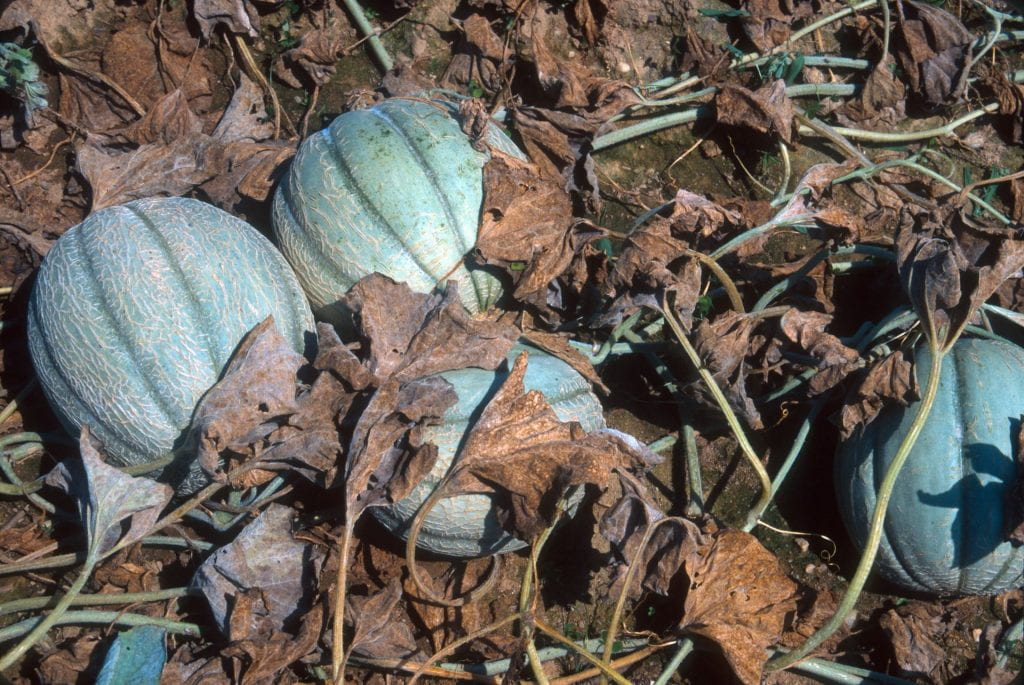
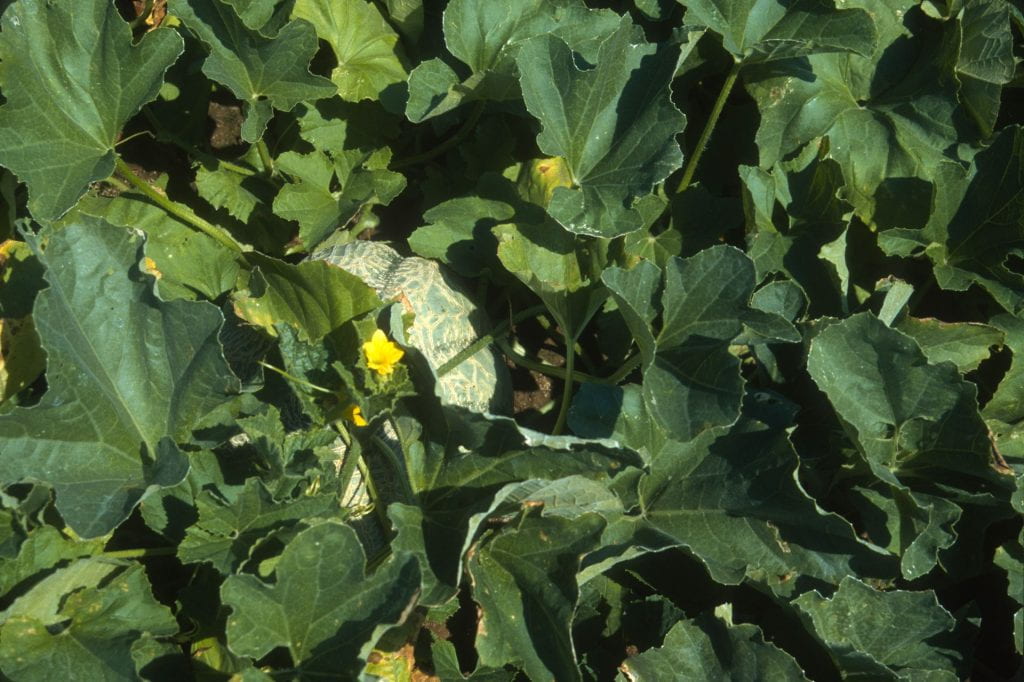
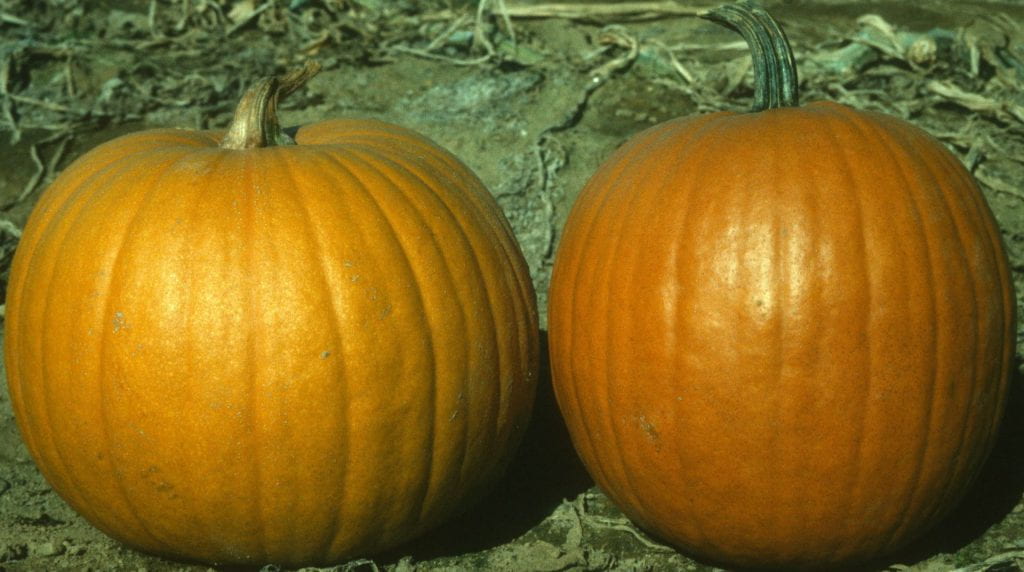
Cultural and biological controls including resistant varieties
Genetic resistance is used extensively in cucumber and melon, and has been incorporated into most other cucurbit crops. Most resistant squash and pumpkin varieties in the United States contain one or two copies of the same major resistance gene from a wild cucurbit. Genetic of resistance is different in cucumber and melon. Recently a decline in the degree of suppression achievable with resistant varieties has been detected indicating adaptation in Podosphaera xanthii. Successive cucurbit plantings should be physically separated or at least planted up-wind of older plantings because older plants can serve as a source of conidia. Fungicides containing antagonistic fungi for biological control have been developed.
Resistant varieties are now available in most crop groups with new varieties released most years. Resistance in cucumber is standard in modern varieties and is so strong it is easy to forget this cucurbit type is susceptible until an Heirloom type is grown. Resistance in other cucurbit crop types is not adequate used alone (without fungicide applications) to prevent impact of powdery mildew on yield. Melon varieties with resistance to pathogen races 1 and 2 have exhibited very good suppression in experiments conducted at LIHREC until recently. Squash and pumpkin exhibit a moderate degree of resistance. Select varieties with resistance from both parents (homozygous resistance) when possible. This term is used in a few catalogues (for example Outstanding Seeds) whereas others use terms like ‘high resistance’ and ‘intermediate resistance’ or ‘tolerance’ to generally refer to homozygous and heterozygous resistance, respectively. Degree of disease suppression obtained with a variety also depends on modifying genes present. Plant breeders are actively searching for new sources of resistance to powdery mildew.
View disease-resistant cucurbits variety lists:
Chemical control – General information
Fungicides should be applied every 7-10 days beginning very early in disease development following detection through an IPM scouting program. Inspect plants weekly beginning at the start of fruit formation (when plants become susceptible). Examine upper and lower (under) surfaces of five older leaves at each of 10 sites or until symptoms are found. When there are multiple varieties in a planting, focus on those that lack resistance to powdery mildew and/or those that start to produce fruit early. Initiate a weekly spray program when symptoms are found. A spring planting of summer squash will become infected before main season crops; therefore, when available, it can be used as an indicator of when the pathogen is developing in the area. For a preventive schedule, applications should begin when first female flowers have opened. To obtain adequate control, fungicide is needed on the undersurface of leaves and on leaves low in the plant canopy because the fungus develops best on these surfaces. This can be best accomplished by using mobile fungicides. Another approach is to improve efficacy of contact materials (i.e. chlorothalonil, sulfur, oil) by maximizing spray coverage on undersurfaces of leaves. This is challenging with cucurbit crops due to leaf size and density. Air-assist sprayers are generally considered one of the most effective means to increase spray deposition on all leaf surfaces, but cucurbit crops are a difficult target for sprayers. Coverage produced by traditional hydraulic boom sprayers can be improved by using narrow nozzle spacing (10 inches is better than 20 inches) and examining output to ensure appropriate overlap for nozzle type used, using adequate volume (around 75 gpa), good pressure (80-120 psi), and changing to nozzle tips that direct the spray at an angle to the canopy (e.g. TwinJet). It is valuable to use water sensitive paper to check spray coverage. Likely it will show improved coverage, but not enough to achieve effective control without using mobile fungicides.
Development of fungicide resistance and consequent control failure is always a concern with mobile fungicides due to their single site mode of action. Strains of the powdery mildew fungus resistant (insensitive) to such fungicides have been found throughout the United States, including New York where research on resistance started in 1990. Reduced sensitivity to fungicides from several chemical groups have been detected in other areas of the world as well. Therefore, tactics should always be used to minimize the potential of resistant pathogen strains being selected, starting when a new product is first available: apply mobile fungicides together with a contact fungicide (tank mix), apply them only when needed most to protect yield (which begins at the start of disease development; contact fungicides alone can suffice late in the season), use highest labeled rates, and alternate among as many different mobile fungicides as possible selecting based on resistance occurrence and on modes of action as indicated by their FRAC code (see link to current fungicide information at top of page). In addition, maximize spray coverage and also use nonchemical (cultural) control practices. Frequency of resistant strains can increase rapidly with use during a growing season, especially when products are used exclusively rather than in a resistance management program.
Several biopesticides approved for organic production are registered for this disease in the United States. These products contain natural ingredients such as botanical oils, bicarbonates, hydrogen dioxide, and microbes that function as biocontrol agents and/or induce resistance in plants. Most are contact materials, thus good coverage is critical for effective control. Products evaluated in university trials have exhibited a range in efficacy with some being as effective as conventional contact fungicides.
Fungicide program
The most important component of an effective management program is an effective fungicide program. And the key to that is using mobile fungicides targeted to powdery mildew. Mobile fungicides are needed for control on the underside of leaves. Because these fungicides have targeted activity, additional fungicides must be added to the program when there is a need to manage other diseases such as downy mildew and Phytophthora blight.
Alternate among targeted, mobile fungicides and apply them with a protectant fungicide to manage resistance development and avoid control failure if resistance occurs, and also to comply with label use restrictions (most mobile fungicides are not permitted used exclusively). The powdery mildew pathogen has a long history of developing resistance to fungicides (it was the first occurrence of resistance in the USA), thus a diversified fungicide program applied to resistant varieties when possible is critical for success. Always implement a resistance management program; do not wait until there is a problem. The goal is to delay development of resistance, not manage resistant strains afterwards.
When to apply fungicides
The action threshold for starting applications is one leaf with symptoms out of 50 older leaves examined. Examine both surfaces of leaves. Starting treatment after this point will compromise control and promotes resistance development. Powdery mildew usually begins to develop around the start of fruit production. Protectant fungicides applied before detection may slow initial development. After detection, continue applying fungicides weekly. Conditions are favorable for powdery mildew throughout the growing season.
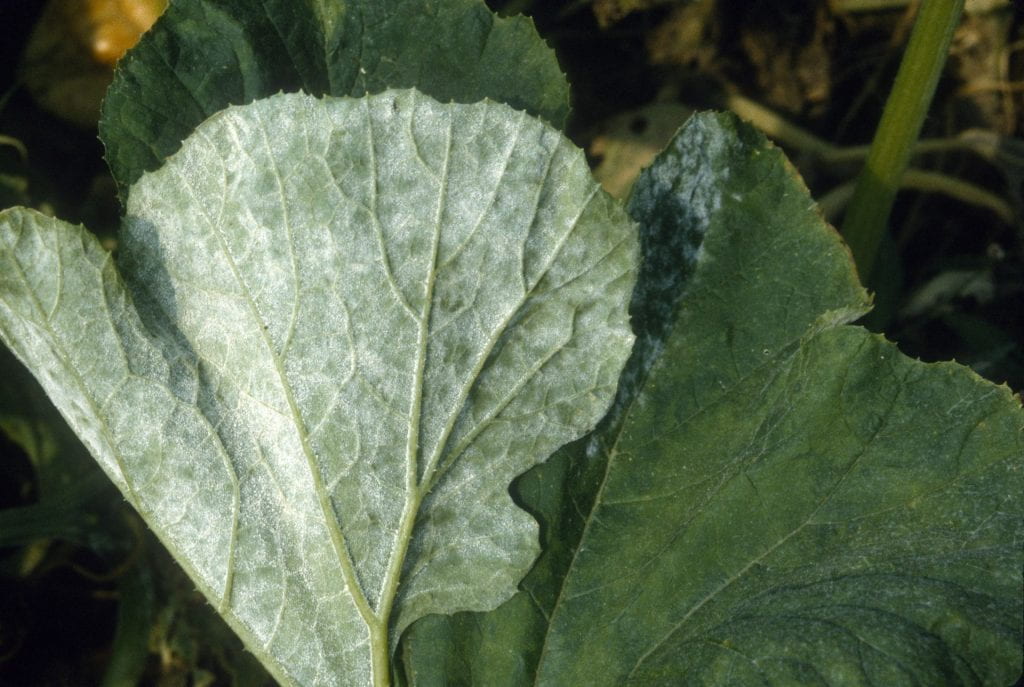
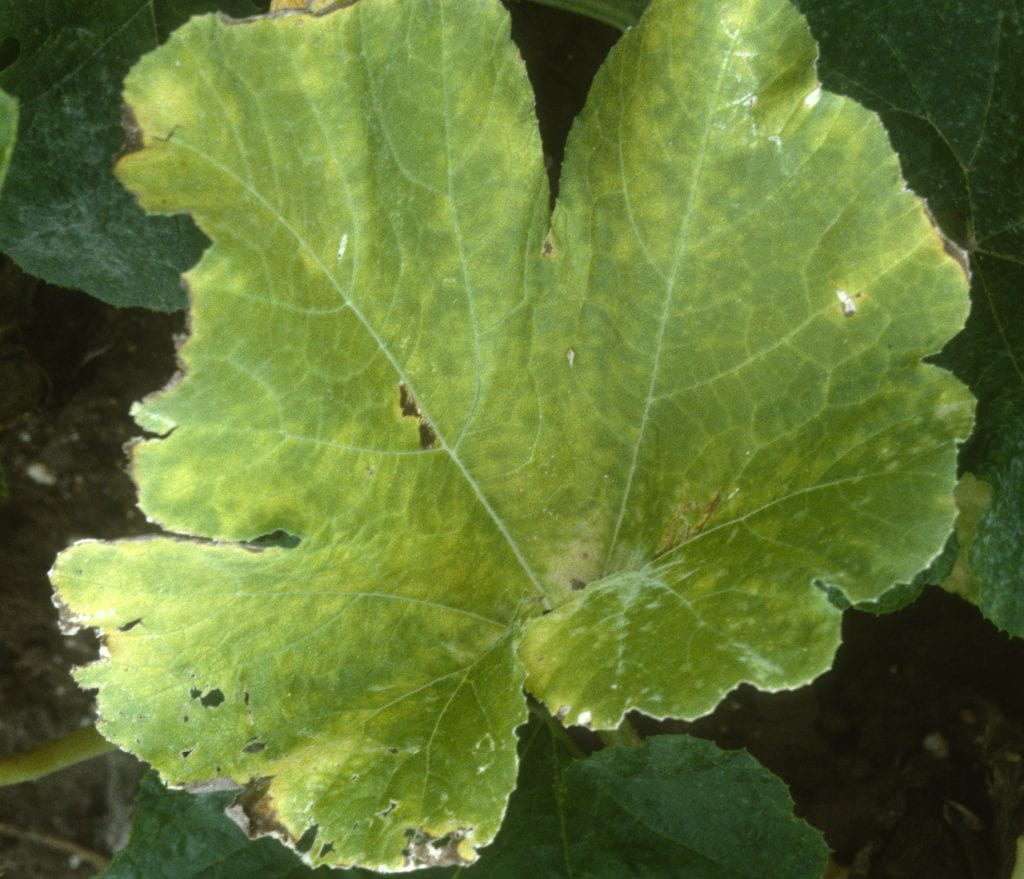
Recommended targeted fungicides
Alternate among targeted, mobile fungicides primarily in the following three chemical groups (principally the first two) and apply with protectant fungicide. Both are recommended to manage resistance development and avoid control failure if resistance occurs, and also to comply with label use restrictions. All targeted fungicides are at risk of resistance developing; FRAC Code 50 and U13 are the only chemistries that resistance has not yet been detected to. The specific fungicide recommendations below are based on results from conducting fungicide evaluations and studying fungicide resistance. An important finding from this work is existence of isolates with multi-fungicide resistance (resistant to fungicides in different FRAC groups), which means applying one of these fungicides will also select for resistance to other fungicides in different FRAC groups. All of the isolates collected at the end of the 2020 growing season (both research and commercial plantings) that were determined to be resistant to Quintec (FRAC 13) were also resistant to Endura (FRAC 7) and Torino (FRAC U6) although these fungicides had not been used (Quintec had been applied), with the exception of the last application in one commercial field being Torino.
- Table of Targeted Fungicides for Cucurbit Powdery Mildew with their resistance status and use recommendations.
- Table of Mobile Fungicides for Mildews and Phytophthora Blight that includes their seasonal use limit, REI and PHI.
- Table of Fungicides for Cucurbit Crops with application cost/A and labeled diseases.
- Results from research on fungicide resistance in the cucurbit powdery mildew pathogen
View and/or download: Federal pesticide labels | New York State labels (enter product name under ‘Names’ in center of page, then click on Search at bottom of this section).
- Vivando (FRAC Code 50, formerly U8) has exhibited excellent control in fungicide evaluations. Activity is limited to powdery mildew. It is recommended used with a silicon adjuvant. Do not mix with horticultural oils. It can be applied three times per year with no more than two consecutive applications. REI is 12 hr. PHI is 0 days. Prolivo is a new fungicide with a new active ingredient in this FRAC group registered in NY April 2018. It was not as effective as Quintec for managing powdery mildew on lower leaf surfaces in a fungicide evaluation conducted at LIHREC in 2016 in which Vivando was not included.
- DMI fungicides (FRAC Code 3) include Proline*, Procure, Luna Experience*†, and Rhyme*† (these considered most effective) plus Aprovia Top*, Inspire Super*, Mettle, and Rally. †not labeled for use on Long Island. *Fungicides labeled for additional cucurbit diseases; see table of Fungicides for Cucurbit Crops and section below on other diseases. Resistance is quantitative. While these fungicides have good efficacy, highest label rate is recommended because the pathogen has become less sensitive to this chemistry. Efficacy has varied among products in fungicide evaluations. Proline is thought to have the greatest inherent activity; it was the most effective fungicide evaluated in 2020 on Long Island. Procure applied at its highest label rate provides a higher dose of active ingredient than the other FRAC 3 fungicides. Five applications can be made at this rate. REI is 12 hr for DMI fungicides. PHI is 0 days for some including Procure; 7 days for others including Proline. Inspire Super (FRAC 3 and 9) is recommended for other labeled diseases. It is expected to provide some control of powdery mildew. but there are other FRAC 3 fungicides with greater intrinsic activity for powdery mildew that are better choices when this is the only disease developing. Cevya (FRAC 3), which was registered in NY in 2021, is not recommended because it was not as effective as other DMI fungicides when tested in 2020 and 2021 (see paragraph below on fungicide evaluations at LIHREC). TopGuard is labeled but not recommended because it has Code 11 ingredient plus same DMI ingredient in Rhyme. Additional products are registered for use outside NY.
- Gatten (Code U13) is the newest fungicide; it was introduced in 2018 and registered in NY in 2020. REI is 12 hr. PHI is 0 days. Activity is limited to powdery mildew. In NY, Gatten can only be applied twice (five times elsewhere) and it is not allowed used on Long Island. It was as effective as Vivando for managing powdery mildew on lower leaf surfaces in a fungicide evaluation conducted at LIHREC in 2019 but not in 2018.
Recommended used sparingly:
- Carboxamide aka SDHI fungicides (FRAC Code 7) registered in NY and recommended are Aprovia Top, Luna fungicides†, and Miravis Prime† (†not allowed used on Long Island). Endura, Pristine and Merivon are not recommended. Resistance to boscalid, the FRAC Code 7 active ingredient in Endura and Pristine has been detected routinely on Long Island since 2009 and likely is the reason their efficacy has varied in fungicide evaluations. Full cross resistance was documented between several carboxamides, including those in Pristine, Merivon and also Fontelis (not registered for use in NY), but not Luna fungicides, through laboratory assays conducted with pathogen isolates resistant and sensitive to boscalid. However, Luna Sensation has exhibited limited control in fungicide evaluations conducted in 2017-2019 on Long Island. Luna Experience is the best choice because it also contains tebuconazole (Code 3), which needs to be considered when developing an alternation program. Luna Sensation is not recommended because it also contains trifloxystrobin (Code 11); resistance to this chemistry is very common. Aprovia Top, Luna Experience, and Miravis Prime are the only Code 7 fungicides recommended. Limit use. Aprovia Top and Luna Experience have the advantage that they contain a second active ingredient with activity for powdery mildew (Code 3). All have 12 hr REI. PHI is 0, 7, and 1 day respectively. Maximum number of applications is 2-5, depending on product and rate. Low rate isn’t recommended.
Recommended used sparingly (one application) if at all:
Torino or Quintec are recommended applied at most once based on recent results from testing powdery mildew isolates collected from commercial and research plantings in NY at season end. Resistance was common where these products were applied, with most isolates resistant to both fungicides even where only one was used. While resistance was not detected in many plantings where neither Torino nor Quintec were applied, indicating these products would likely have been effective, it is possible resistance was at a low frequency not detectable with only about 8 isolates tested per planting. Additionally, resistance was detected in some plantings where neither fungicide was applied documenting that resistant isolates are common and competitive. It is not possible to predict efficacy of Torino and Quintec without testing isolates in a planting prior to applying that season. Results from prior year testing in a location provide some indication of expected resistance occurrence, but the pathogen population changes yearly reflecting ability of the pathogen’s wind-dispersed spores to be dispersed widely. Seedling bioassays conducted on Long Island (2017-2021) have yielded some useful information about occurrence of resistance, but bioassays conducted at the start of powdery mildew development have been hampered by high summer temperatures in the greenhouse impacting powdery mildew development.
- Torino (FRAC Code U6) exhibited excellent control in fungicide evaluations until recently. It failed in an experiment in North Carolina in 2016 and on Long Island in 2017, where resistance to Torino was detected in pathogen isolates. Torino resistance has been detected every year since on Long Island and in upstate NY when examined in 2020 and 2021. Activity is limited to powdery mildew. Recommended applied at most once to a crop where Quintec not applied; labeled for twice to a field in a 12-mo period. REI is 4 hr. PHI is 0 days.
- Quintec (FRAC Code 13) was consistently effective in fungicide evaluations conducted on Long Island until 2019 when it was significantly less effective than Vivando for the first time in the fungicide evaluation conducted annually on Long Island. This was not surprising because insensitivity to a high concentration of Quintec (similar to the dose when applied in the field) has been detected in some pathogen isolates collected from commercial fields and/or fungicide-treated research fields at the end of the growing season on Long Island and/or upstate NY since 2015. Resistant isolates evidently were sufficiently uncommon most of the season in 2015-2018 and also 2020 not to impact Quintec efficacy. Because Quintec resistance is being detected every year, especially in plantings where applied, Quintec is now recommended applied at most once to a crop where Torino was not applied; label permits a crop maximum of four applications. Aerial applications are not permitted and no more than two consecutive applications. Activity is limited to powdery mildew. It is the only mobile fungicide that does not move into leaves: it redistributes to foliage where spray was not directly deposited, including the underside of leaves, through diffusion and a continual process of absorption and desorption in the cuticular waxes of foliage. Labeled for use on non-edible peel crops: melons, pumpkin, and winter squash. REI is 12 hr. PHI is 3 days.
Fungicides classified for “Restricted Use” in New York: Aprovia Top, Gatten, Miravis Prime, and Procure.
No longer recommended. Resistant pathogen strains are sufficiently common in NY to affect the efficacy of the following fungicides which in the past were highly effective:
Topsin M (FRAC Code 1; MBC fungicide).
QoI fungicides (Code 11), which include Quadris, Cabrio and Flint.
SDHI fungicides (Code 7) containing boscalid (Endura and Pristine) or an active ingredient that has exhibited full cross resistance in laboratory testing of pathogen isolates (Merivon).
Recommended protectant fungicides. Many fungicides have contact activity for powdery mildew; mancozeb is an exception. They include chlorothalonil, sulfur, copper, mineral oil, and several biopesticides. Many of these products are approved for organic production (see list below).
Sulfur is one of the most effective and least expensive products. Its activity is limited to powdery mildew, thus it is especially useful early in disease development when other diseases are not a concern, including as a preventive application. Microencapsulated formulations are recommended. Melons are sensitive to sulfur especially when hot; there are tolerant varieties.
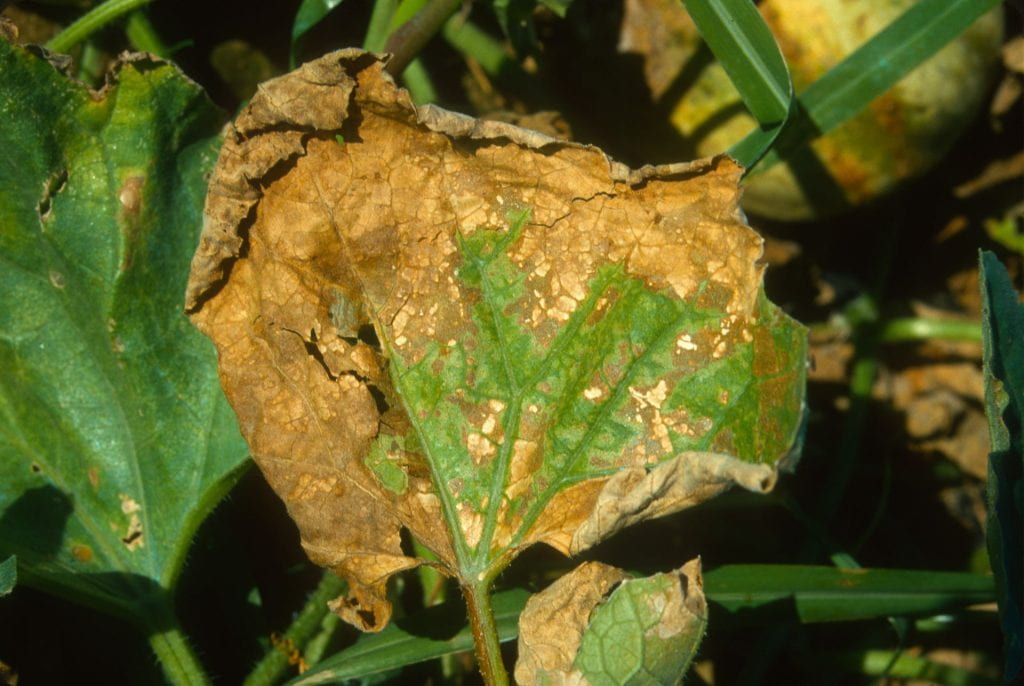
Fungicide evaluations conducted each year on pumpkin at LIHREC on Long Island include fungicides at risk for resistance tested alone (this is neither a labeled nor recommended commercial use pattern for these fungicides; it is done in efficacy evaluations to determine if resistance affects control). Not every fungicide chemistry prone to resistance is tested every year. Efficacy is based on control achieved on lower (under) surface of leaves because this is where the disease develops best. In 2023, Vivando was significantly more effective than Prolivo (both FRAC 50 fungicides): 86% vs 59% control of powdery mildew on lower leaf surfaces. Regev was ineffective. Most effective control (96%) was obtained with Vivando applied in alternation with a DMI fungicide (Proline and Procure) starting after the IPM threshold. In 2022 Cevya was again only moderately effective (54% control on lower leaf surfaces), confirming 2020 and 2021 results, although this time it was tested on an intermediate resistant variety and preventive application schedule, while Prolivo provided 87% control, which was better than in the 2016 experiment perhaps due to these test parameters and using an adjuvant as recommended by the manufacturer. In another experiment with the usual susceptible pumpkin variety, the recommended program of Vivando applied in alternation with Proline and Procure starting after the IPM threshold was reached provided 90% control. In 2021 Cevya was only moderately effective (56% control on lower leaf surfaces), confirming 2020 results, while excellent control (96%) was obtained with Proline alternated with Vivando, a program recommended for Long Island. In 2020 Proline provided exceptional control (99.5% control on lower leaf surfaces); Luna Experience, Quintec, Vivando, and Procure also performed well (89-95%) while Cevya, a new FRAC 3 fungicide, did not (44% at highest rate tested). The FRAC 7 active ingredient in Luna pre-mix fungicides (fluopyram) was shown to be highly effective through testing Luna Privilege, which has only fluopyram; it is not labeled for powdery mildew. In 2019 Vivando was the most effective single product tested providing control statistically similar to the alternation program (Vivando, Quintec, Proline), albeit numerically lower control (75 and 92% control on lower leaf surfaces). Gatten was as effective as Vivando (65%); Luna Sensation and Quintec were less effective (47 and 40%). In 2018 Vivando was most effective albeit not significantly better than Quintec, which was not significantly better than Luna Sensation (54, 42, and 28%)). In 2017 Torino, Pristine, and Luna Sensation were ineffective, while Vivando was most effective (80%) albeit not significantly better than Quintec (72%) or Procure (54%). In 2016 Quintec and Procure were as effective as an alternation program (98, 91, and 97%) while Pristine and Prolivo were significantly less effective (43 and 66%). In 2015 Quintec, Pristine, and Vivando were as effective as an alternation program (69-78%). Quintec and Vivando were the most effective of the targeted fungicides evaluated in 2014 (96 and 98%); Pristine was moderately effective (54%); Procure was slightly but not significantly better (70%). In 2013 Quintec, Pristine, and Procure provided excellent control (93-99%). In 2012 Pristine and Fontelis were ineffective (albeit treated pumpkins were numerically less severely affected by powdery mildew than the non-treated plots) while Quintec was very effective (96%) and Procure was moderately effective (57%). These experiments have documented year-to-year variation in the pathogen population. See also table of results from these and previous experiments at LIHREC and experiments at other universities.
Fungicides Labeled for Other Diseases in Addition to Powdery Mildew.
- Proline (FRAC 3). Fusarium blight and gummy stem blight.
- Rhyme (FRAC 3). Gummy stem blight.
- Luna Experience (FRAC 3 and 7). Alternaria leaf spot, anthracnose, gummy stem blight, and belly rot.
- Aprovia Top (FRAC 3 and 7). Anthracnose, Alternaria leaf blight, gummy stem blight, and Plectosporium blight.
- Inspire Super (FRAC 3 and 9). Alternaria leaf blight, anthracnose, gummy stem blight, Plectosporium blight, and Septoria leaf spot
- Miravis Prime (FRAC 3 and 12). Alternaria leaf blight and spot, gummy stem blight, and scab.
Organic fungicides
Printer-friendly .pdf version of this section on organic fungicides
Following is a list of some biopesticides and other organic fungicides (mineral oil) labeled for cucurbit powdery mildew. There are several formulations of copper and sulfur not included. Each product name is followed by active ingredient. Most products are labeled for managing other diseases which are included. Products listed with OMRI (Organic Materials Review Institute) are NOP compliant. Check state registration: each product may not be registered in all states. Also, always check with your certifier before purchasing any product. ‘No Ag Label’ indicates an agricultural label was not found for the product.
Results of product evaluations conducted at LIHREC and at Cornell AgriTech.
- Actinovate AG. 0.0371% Streptomyces lydicus strain WYEC 108. For best results with applications to foliage, label indicates to use a non-ionic spreader-sticker. OMRI-listed. EPA Reg. No. 73314-1.
- Aviv. 0.08% Bacillus subtilis strain IAB/BS03. OMRI-listed. EPA Reg. No. 91473-1-86182.
- Carb-O-Nator. 85% potassium bicarbonate. OMRI-listed. EPA Reg. No. 70051-117.
- Cinnerate. 60% cinnamon oil. OMRI-listed. Exempt from EPA registration.
- Companion. 0.03% Bacillus subtilis strain GB03. EPA Reg. No. 71065-3.
- DES-X insecticidal soap. 47% potassium salts of fatty acids. OMRI listed. EPA Reg. No. 67702-22-70051.
- Double Nickel 55 LC and WDG. Bacillus amyloliquefacinens strain D747, 98.8% and 25%, respectively. OMRI-listed. EPA Reg No. 70051-107 and 108, respectively.
- EcoSwing Botanical Fungicide. 82% extract of Swinglea glutinosa. OMRI-listed. EPA Reg. No. 10163-357.
- ECOWORKS EC. 70% cold pressed neem oil. OMRI-listed. EPA Reg. No. 89152-4.
- EF400. 8.2% clove, 8.1% rosemary, and 6.7% peppermint. Exempt from EPA registration.
- FungOUT. 1.07% citric acid. OMRI listed. Exempt from EPA registration.
- GreenFurrow BacStop. 2.0% thyme, 2.0% clove & clove oil, 1.5% cinnamon, 1.0% peppermint & peppermint oil, and 1.0% garlic oil. Recommended used with EF400. Exempt from EPA registration.
- Howler. 50% Pseudomonas chlororaphis strain AFS009. OMRI listed. EPA Reg. No. 91197-3-92488.
- Organic JMS Stylet-oil. 97.1% paraffinic oil. OMRI-listed. EPA Reg. No. 65564-1.
- Kaligreen . 82% potassium bicarbonate. OMRI-listed. EPA Reg. No. 11581-2.
- KeyPlex 350 OR. 0.063% yeast extract hydrolysate from Saccharomyces cerevisiae. Combination of defensive proteins (alpha-keto acids) and secondary and micronutrients. EPA Reg. No. 73512-4.
- KOPA insecticidal soap. 47% potassium salts of fatty acids. OMRI listed. EPA Reg. No. 67702-11-59807.
- LALSTOP G46 WG. 93.0% Gliocladium catenulatum strain J1446. OMRI listed. EPA Reg. No.: 64137-13.
- LifeGard WG. 40% Bacillus mycoides isolate J. Biological Plant Activator. OMRI-listed. EPA Reg No. 70051-119.
- Mildew Cure (formerly GC-3 Organic fungicide). 30% cottonseed oil, 30% corn oil, 23% garlic extract. OMRI-listed. Exempt from EPA registration.
- MilStop. 85% potassium bicarbonate. OMRI-listed. EPA Reg. No. 70870-1-68539.
- M-Pede insecticidal soap. 49% Potassium salts of fatty acids. OMRI-listed. EPA Reg. No. 10163-324.
- Organocide. 5% sesame oil. OMRI-listed. Exempt from EPA registration.
- OSO. 5% polyoxin D zinc salt. OMRI-listed. EPA Reg No. 68173-4-70051.
- OxiDate 2. 27% hydrogen dioxide. OMRI-listed. EPA Reg. No. 70299-2.
- PerCarb. 85% sodium carbonate peroxyhydrate. OMRI listed. EPA Reg. No. 70299-15.
- Prestop. 93% Gliocladium catenulatum strain J1446. OMRI listed. EPA Reg. No. 64137-13.
- Problad Verde. 20% Banda de Lupinus albus doce (BLAD). OMRI listed. EPA Reg. No. 84876-2.
- Procidic. 3.5% Citric acid. NOP compliant; registered for use in organic agriculture with Washington State Dept of Ag. Exempt from EPA registration.
- Promax. 3.5% Thyme oil. OMRI-listed. Exempt from EPA registration.
- Rango. 70% cold pressed neem oil. OMRI listed. EPA Reg. No. 88760-10.
- Regalia. 5% Extract of Reynoutria sachalinensis. OMRI-listed. EPA Reg. No. 84059-2.
- Romeo. 94.1% cerevisane (cell walls of Saccharomyces cerevisiae strain LAS117). OMRI listed. EPA Reg. No. 91810-2.
- Serenade ASO. 1.34% Bacillus subtilis strain QST 713. OMRI listed. EPA Reg. No. 264-1152.
- Serenade Opti. 26.2% Bacillus subtilis strain QST 713. OMRI-listed. EPA Reg. No. 264-1160.
- Serifel. 9.9% Bacillus amyloliquefacinens strain MBI 600. OMRI-listed. EPA Reg No. 71840-18.
- Sil-Matrix. 29% potassium silicate. OMRI-listed. EPA Reg. No. 82100-1.
- Sonata. 1.38% Bacillus pumilus strain QST 2808. OMRI-listed. EPA Reg. No. 69592-13.
- Sporan EC2. 16% rosemary oil, 10% clove oil, 10% thyme oil, 2% peppermint oil. OMRI-listed. Exempt from EPA registration.
- Surround WP. 95% kaolin. OMRI listed. EPA Reg. No. 61842-18.
- Taegro 2. 13% Bacillus subtilis var. amyloliquefaciens strain FZB24. OMRI-listed. EPA Reg. No. 70127-12.
- Thyme Guard. 23% thyme oil extract. Determined to be NOP compliant by Washington State Dept of Ag. Exempt from EPA registration.
- Thymox Control. 27% thyme oil. OMRI-listed. Exempt from EPA registration.
- Thyme Guard. 23% thyme oil extract. Exempt from EPA registration. Determined to be NOP compliant by Washington State Dept of Ag.
- Timorex Act. 12.5% tea tree oil. OMRI-listed. EPA Reg. No. 86182-3-88783.
- Triathlon BA. 98.85% Bacillus amyloliquefaciens strain D747. OMRI listed. EPA Reg. No. 70051-107-59807.
- Trilogy. 70% clarified hydrophobic extract of neem oil. OMRI-listed. EPA Reg. No. 70051-2.
- TriTek. 80% mineral oil. OMRI-listed. EPA Reg. No. 48813-1.
Summary
To manage powdery mildew effectively in cucurbit crops:
- Select resistant varieties.
- Inspect crops routinely for symptoms beginning at the start of fruit development.
- Apply targeted fungicides weekly with protectant fungicides and alternate amongst available chemistry based on FRAC Group code, starting at the action threshold of 1 affected leaf out of 50 older leaves.
- Add new fungicides to the program when they become available. Substitute new for older product if they are in the same FRAC group.
Please Note: The specific directions on fungicide labels must be adhered to — they supersede these recommendations, if there is a conflict. If you are farming organically, before purchase make sure product is registered in your state and approved by your certifier. Any reference to commercial products, trade or brand names is for information only; no endorsement is intended. For up-to-date information on labeled fungicides see Cornell Integrated Crop and Pest Management Guidelines for Commercial Vegetable Production
More information/prepared by:
Margaret Tuttle McGrath
Associate Professor
Long Island Horticultural Research and Extension Center (LIHREC)
Plant Pathology and Plant-Microbe Biology Section
School of Integrative Plant Science
College of Agriculture and Life Sciences
Cornell University
mtm3@cornell.edu


